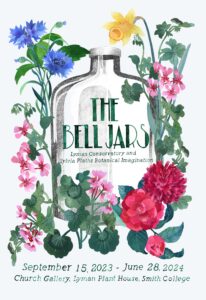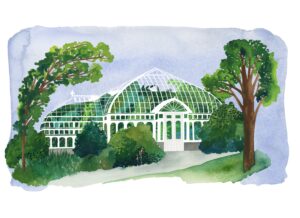 The collection of essays presented here is part of a year-long exhibit held at the Smith College Botanic Garden’s Lyman Conservatory during the 2023-24 academic year: “The Bell Jars: Lyman Conservatory and Sylvia Plath’s Botanical Imagination.” In a Spring 2023 Anthropology course, Smith College students majoring in Biological Science, English, Environmental Science and Policy, Computer Science, Anthropology, Government, and more gathered together to investigate the possibility that conservatories are relevant to our understanding of the human condition, focusing on Sylvia Plath’s (‘55) botanical encounters at Lyman in the 1950s.
The collection of essays presented here is part of a year-long exhibit held at the Smith College Botanic Garden’s Lyman Conservatory during the 2023-24 academic year: “The Bell Jars: Lyman Conservatory and Sylvia Plath’s Botanical Imagination.” In a Spring 2023 Anthropology course, Smith College students majoring in Biological Science, English, Environmental Science and Policy, Computer Science, Anthropology, Government, and more gathered together to investigate the possibility that conservatories are relevant to our understanding of the human condition, focusing on Sylvia Plath’s (‘55) botanical encounters at Lyman in the 1950s.
Plant conservatories are greenhouses used to grow, research, and display plants from far-away places. Often understood merely as spaces to encounter beautiful flowers, they can also be transformative sites of plant-human intimacy, care, and contemplation. Sylvia Plath, one of the 20th century’s most important poets and novelists, took a year-long General Botany course at Lyman as a first-year student in 1950-51, and botanical images and tropes run throughout her work, partly because of this experience. For example, the bell jar at the center of Plath’s iconic novel, The Bell Jar, is a botanical technology that she used during laboratory exercises on plant physiology and transpiration in the first weeks of that course.
Student essays examine one plant species that features in Plath’s work, accounting for its ecology, geography, and taxonomy; the symbolic work it does in Plath’s writing; and the historical context in which Plath came to know it. Collectively, they demonstrate how Plath’s education in botanical science helped her to theorize the human experience, particularly for women living under the oppressive atmospheres of 1950s USA patriarchy.

Acknowledgements
We would like to thank staff at the Smith College Botanic Garden for hosting our class and for making this project possible through their consultations, guest lectures, and more. Particular thanks go to Lily Carone and Sarah Loomis for their substantial contributions. Emily Norton from the Design Thinking Initiative ran a series of important workshops during the semester to assist us in our work. Travis Grandy from IT Services helped to design this website. Smith College Special Collections was important in facilitating our archival work, for which we are grateful. We would also like to thank the following individuals for presenting during the course: Lily Carone, Amanda Golden, Jess Gersony, Jimmy Grogan, Karen Kukil, Melissa Parrish, Kelly Vogel, and Nanci Young. Thanks to Meadow Jones (’06) for sharing her work on William F. Ganong’s botanical apparatus, and thanks to Carolyn Wetzel for facilitating that connection. All illustrations used on this site are by Malin Gyllensvaan (except where specified) and used with permission. Finally, we would like to thank Elisa Kay Sparks for inspiring this web research project through their Virginia Woolf Herbarium.